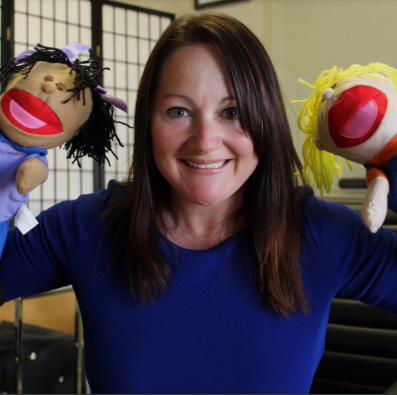Creating a Polyvagal-informed Play Therapy Office

Jackie Flynn, Ed.S, LMHC-S, RPT
Program Goals
Through an integrative theoretical framework, play therapists will be invited to explore the neuroscience of communication, emotional wellness, social relationships, and personal strengths through the playful integration of Play Therapy and the Polyvagal theory to teach participants practical applications to assist in regulating the nervous system, substantially impacting treatment effectiveness. By integrating foundational Play Therapy knowledge with the Polyvagal theory, play therapists will explore the Therapeutic Powers of Play in order to create a deeper understanding of the brain-body connection.
Participants will learn how to set up a Polyvagal-informed Play Therapy Office that considers the unique ways the autonomic nervous system impacts children's capacity to manage stress, express themselves, regulate emotional states, and navigate relationships.
This workshop will serve as a deep dive into foundational concepts of Polyvagal theory and best practices when integrating the neuroscience of Play Therapy when setting up healing spaces when working with children and adolescents.
After the workshop, therapists will be able to:
- Define the neuroscience of emotions, communication, and the social engagement system as they present in the play therapy office;
- List two ways of successfully integrating neuroscience with play therapy and the therapeutic powers of play;
- Apply 5 or more play therapy techniques as they relate to perception, interoception, and neuroception;
- List two ways that knowing about the three states of the Autonomic Nervous System helps play therapists in the treatment of children with complex trauma histories;
- List 5 or more play therapy items and office supplies that may increase children's capacityto manage stress;
- Name two play therapy techniques that can help children with self-regulation;
- Define the term “playful polyvagal-informed lens;”
- List two things that play therapists can do immediately, to demonstrate the importance of using a polyvagal-informed play therapy practice.
- Analyze the neuroscience of emotions, communication, and the social engagement system, successfully integrating them with play therapy and the therapeutic powers of play.
- Apply 5 or more play therapy techniques as they relate to perception, interoception, and neuroception.
- Investigate the functions of the three states of the Autonomic Nervous System, formulating how understanding neurobiology is necessary the treatment of children with complex trauma histories.
- Demonstrate 5 or more play therapy items and office supplies that may increase children's capacity to manage stress, express themselves, regulate emotional states, and navigate relationships through a playful polyvagal-informed lens.
References
Dana, D. (2018). The Polyvagal theory in therapy: Engaging the rhythm of regulation (Norton series on interpersonal neurobiology). W.W. Norton & Company.
trauma: Interoception, neuroception, and the embodiment of unspeakable events in treatment of complex PTSD, dissociative disorders and childhood traumatization. European Journal of Trauma & Dissociation, 4 (3), 100164.
Gray, A. E. L. (2017). Polyvagal-informed dance/movement therapy for trauma: A global perspective. American Journal of Dance Therapy, 39(1), 43-46.
Hudspeth, E. F. & Matthews, K. (2015). Neuroscience and play therapy: The neurobiologically-informed play therapist. In K.J. O’Connor, C. E. Schaefer, & Braverman, L. D. (Eds.), Handbook of Play Therapy. John Wiley & Sons, Inc. https://doi.org/10.1002/9781119140467.ch31
Huttunen, M. & Mednick, S. (2018). Polyvagal theory, neurodevelopment, and psychiatric disorders. Irish Journal of Psychological Medicine, 35 (1), 9-10. doi:10.1017/ipm.2017.66
Lowenstein, L. (2010). Creative family therapy techniques: Play, art, and expressive activities to engage children in family sessions. Champion Press.
Melancon, S. (2021). Safety, co-regulation, and polyvagal theory. In Davis-Floyd, R. (Ed.), Birthing Techno-Sapiens: Human-Technology Co-Evolution and the Future of Reproduction. Routledge.
Placid, R. (2020). The polyvagal theory: How to activate your body's natural healing power to reduce anxiety, trauma, and depression (Norton series on interpersonal neurobiology). W.W. Norton & Company.
Porges, S. W. (2009). The polyvagal theory: New insights into adaptive reactions of the autonomic nervous system. Cleveland Clinic Journal of Medicine, 76 (2), S86–S90. https://doi.org/10.3949/ccjm.76.s2.17
Porges, S. W. (2011). The polyvagal theory: Neurophysiological foundations of emotions, attachment, communication, and self-regulation. W.W. Norton.
Porges, S. W. (2021). Polyvagal theory: A biobehavioral journey to sociality. Comprehensive Psychoneuroendocrinology, 7, 1-7. https://doi.org/10.1016/j.cpnec.2021.100069
Schroeter, V. (2016). Polyvagal Theory. Introduction for Somatic Psychotherapy. Bioenergetic Analysis, 26 (1), 9– 40. https://doi.org/10.30820/9783837972573-9
Siegel, D. J., & Bryson, T. P. (2012). The whole-brain child. Constable & Robinson.
Siegel, D. J., & Bryson, T. P. (2019). The yes brain: How to cultivate courage, curiosity, and resilience in your
child. Bantam.
Wagner, D. (2015). Polyvagal theory and peek-a-boo: How the therapeutic pas-de-deux heals attachment trauma.
Body, Movement, and Dance in Psychotherapy, 10 (4), 256-265. doi:10.1080/17432979.2015.1069762
General Course Information
This course is limited to 20 participants and is designed to facilitate experiential work, group discussion, and processing of clinical material. Participants will have ample opportunity to discuss their specific needs and clinical questions. Participant feedback will be sought out throughout the day.
Clinical case discussions will adhere to HIPPA regulations regarding client confidentiality.
Target audience is Mental Health Professionals: Social Workers, Psychologists, Licensed Professional Counselors and Licensed marriage and Family Therapists.
The program is Beginning Level
This event is sponsored by Starbright Training Institute. Starbright Training Institute is approved by the Association for Play Therapy to offer continuing education specific to play therapy (APT Approved Provider No. 96-029).
For information about continuing education credit, fees, and deadlines for cancellations/refunds, please see https://starbrighttraininginstitute.com/. It is the participant's responsibility to check with their individual state boards to verify CE requirements for their state.
Myriam Goldin, LCSW; RPT-S, is Director of Starbright Training Institute. Phone: 703-980-2886. Email: starbright.inst@outlook.com Web Page: starbrighttraininginstitute.com
Grievance Policy
Starbright Training Institute seeks to ensure equitable treatment of every person and to make every attempt to resolve grievances in a fair manner. Please submit a written grievance to: Myriam Goldin, LCSW; RPT-S, Director of Starbright Training Institute. Phone: 703-980-2886. Email: starbright.inst@outlook.com Web Page: starbrighttraininginstitute.com
Grievances would receive, to the best of our ability, corrective action in order to prevent further problems.
Accommodations for the Differently Abled
Starbright Training Institute’s training facilities are handicap accessible. Individuals needing special accommodations please contact the Director of Starbright Training Institute. See contact information above.